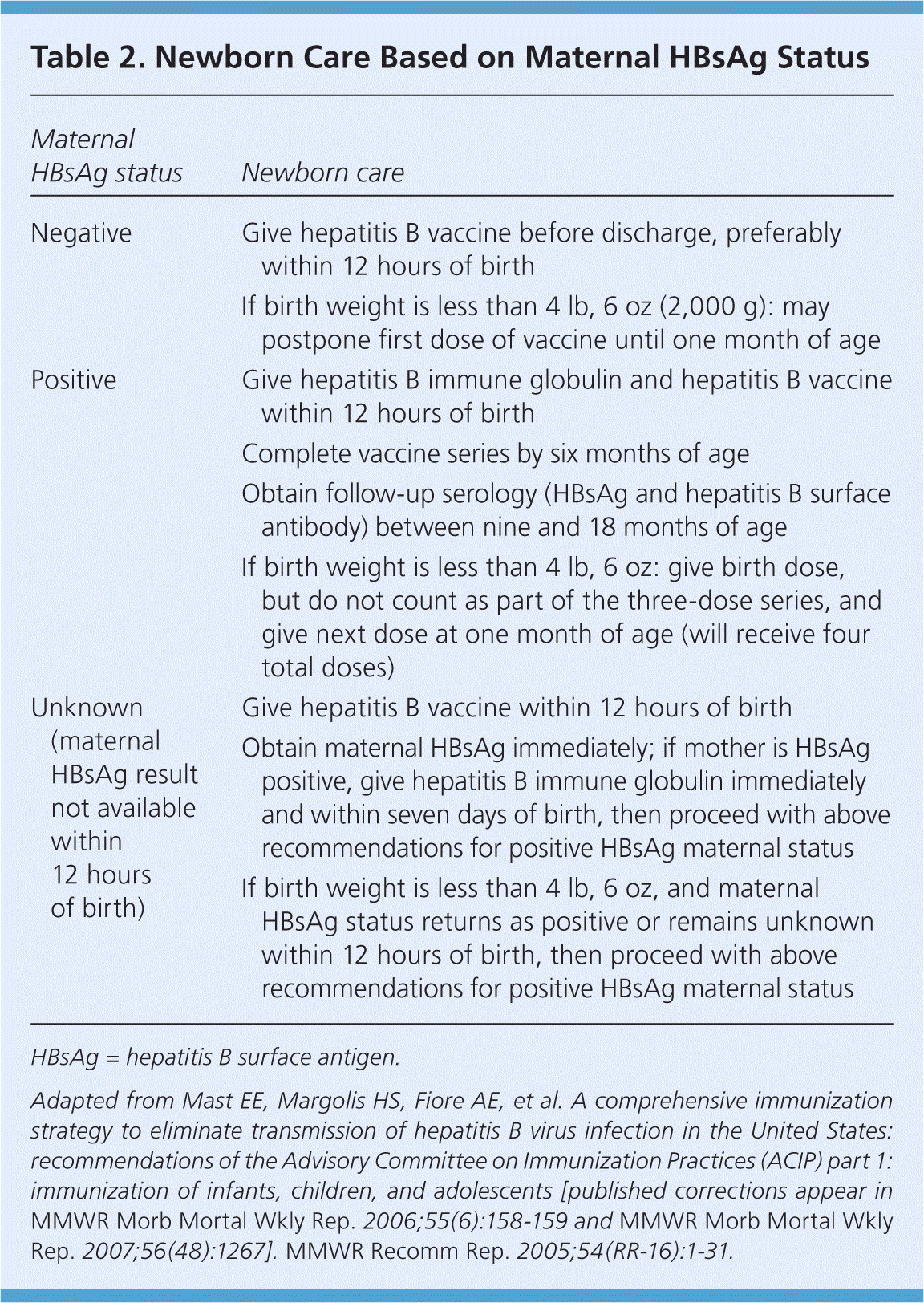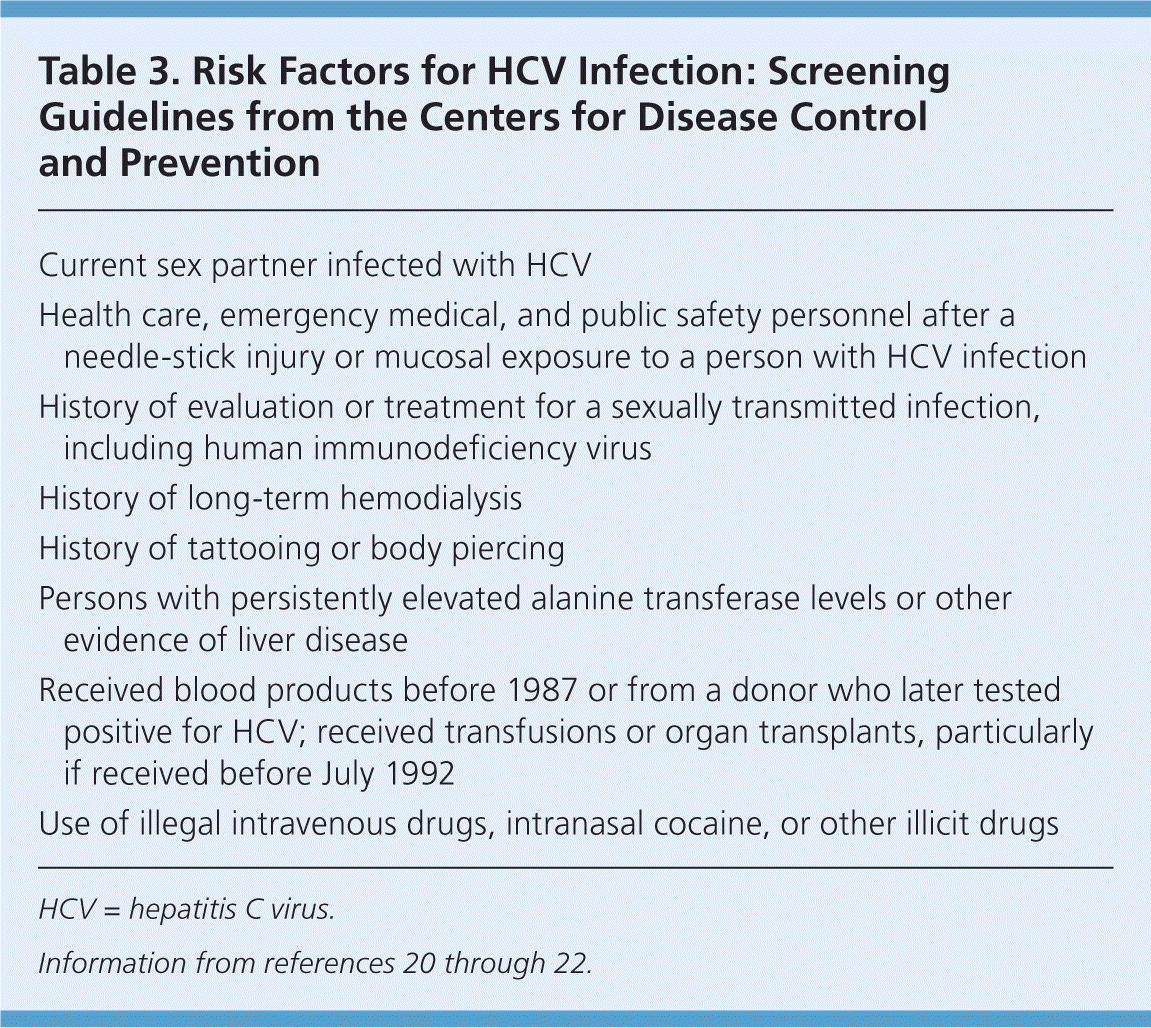
Am Fam Physician. 2010;82(10):1225-1229
Family physicians encounter diagnostic and treatment issues when caring for pregnant women with hepatitis B or C and their newborns. When hepatitis B virus is perinatally acquired, an infant has approximately a 90 percent chance of becoming a chronic carrier and, when chronically infected, has a 15 to 25 percent risk of dying in adulthood from cirrhosis or liver cancer. However, early identification and prophylaxis is 85 to 95 percent effective in reducing the acquisition of perinatal infection. Communication among members of the health care team is important to ensure proper preventive techniques are implemented, and standing hospital orders for hepatitis B testing and prophylaxis can reduce missed opportunities for prevention. All pregnant women should be screened for hepatitis B as part of their routine prenatal evaluation; those with ongoing risk factors should be evaluated again when in labor. Infants of mothers who are positive for hepatitis B surface antigen should receive hepatitis B immune globulin and hepatitis B vaccination within 12 hours of birth, and other infants should receive hepatitis B vaccination before hospital discharge. There are no effective measures for preventing perinatal hepatitis C transmission, but transmission rates are less than 10 percent. Perinatally acquired hepatitis C can be diagnosed by detecting hepatitis C virus RNA on two separate occasions between two and six months of age, or by detecting hepatitis C virus antibodies after 15 months of age.
Maternal infection with hepatitis B virus (HBV) or hepatitis C virus (HCV) can expose the newborn to a subsequent chronic hepatitis infection. However, perinatally acquired HBV is a largely preventable condition. The risk of vertical transmission depends on the time at which the pregnant woman acquired HBV infection, and on her statuses of hepatitis B surface antigen (HBsAg) and hepatitis B e antigen (HBeAg). Without prophylaxis, the risk of perinatal HBV infection in an infant with an HBsAg positive mother is less than 10 percent if the mother's HBeAg status is negative, but is 70 to 90 percent if her HBeAg status is positive.1 If infected at birth, an infant has approximately a 90 percent chance of becoming a chronic HBV carrier and, when chronically infected, has a 15 to 25 percent risk of dying in adulthood from cirrhosis or liver cancer.2 However, the combination of hepatitis B vaccine and hepatitis B immune globulin is 85 to 95 percent effective in reducing HBV infection from vertical transmission when given within 12 hours of birth.1
| Clinical recommendation | Evidence rating | References |
|---|---|---|
| All pregnant women should receive routine prenatal screening for hepatitis B surface antigen. | C | 5 |
| Hepatitis B vaccine, hepatitis B immune globulin, or both can prevent perinatal transmission of hepatitis B infection. | A | 19 |
| Routine prenatal HCV screening is not recommended; however, antibody screening is appropriate for women with risk factors for infection. | C | 21 |
| The diagnosis of vertically acquired HCV can be made by HCV RNA detection on two separate occasions between two and six months of age, or by the presence of HCV antibody after 15 months of age. | C | 28 |
The diagnosis of vertical HCV transmission is not straightforward because many infants born to a mother with HCV infection passively acquire transplacental immunoglobulin G antibodies up to 18 months after birth.3 A study on vertical transmission of HCV showed a 1.7 percent rate of transmission in pregnant women who were positive for HCV antibodies and negative for HCV RNA.4 If the mother was positive for HCV RNA, the rate of vertical transmission was 4.3 percent; if she was coinfected with human immunodeficiency virus, the rate was 19.4 percent.
Hepatitis B
SCREENING
The U.S. Preventive Services Task Force supports screening all pregnant women at the first prenatal visit to reduce vertical transmission of HBV.5 The American Academy of Family Physicians, the American College of Obstetricians and Gynecologists, the American Academy of Pediatrics, and the Centers for Disease Control and Prevention also provide similar recommendations; the American Academy of Pediatrics adds screening for adolescents.6–8 Pregnant women with unknown HBsAg status or new or continuing risk factors (Table 15,9) should be screened upon admission to the hospital or other delivery setting.5

| Coinfected with hepatitis C virus or human immunodeficiency virus |
| History of evaluation or treatment for a sexually transmitted infection |
| Inmate at a correctional facility |
| In need of immunosuppressive therapy |
| More than one sex partner during the previous six months |
| Patient or patient's parents born in regions with high hepatitis B virus endemicity and patient not vaccinated as an infant |
| Recent or current use of intravenous drugs |
| Sex partner or household contact who is positive for hepatitis B surface antigen |
| Undergoing hemodialysis |
MATERNAL TREATMENT
Proper management of maternal hepatitis during the prenatal phase ensures better outcomes in the infant. Pregnant women who are positive for HBsAg should be referred to the appropriate local case management program, as well as for counseling and medical management of HBV infection.10,11 Patients should be advised that all household, sexual, and needle-sharing contacts should be tested for HBV and vaccinated if not infected. Patients should also be educated about the need for infant immunoprophylaxis at birth. If risk factors for HBV infection exist during their pregnancy, women should receive the hepatitis B vaccine series regardless of HBsAg status.12
Pregnant women who are positive for HBsAg should be referred to a subspecialist for evaluation and management of chronic HBV infection.12 Therapeutic agents have been approved by the U.S. Food and Drug Administration for the treatment of chronic HBV infection. Most of these medications are pregnancy category C; however, telbivudine (Tyzeka) and tenofovir (Viread) are pregnancy category B medications.13,14 Recent research demonstrated some potential benefit from lamivudine (Epivir) in decreasing the risk of in utero HBV infection during the last months of pregnancy 15; however, this intervention is of limited value because transmission usually occurs at the time of delivery. Hospitalization of pregnant women with acute HBV infection is recommended if there are any signs of liver decompensation, such as ascites, hepatic encephalopathy, jaundice, coagulopathy, or variceal bleeding. Patients should remain hospitalized until treatment is initiated or liver function test results improve.6
PERINATAL PREVENTION AND TREATMENT
Newborns are most commonly infected with HBV via exposure to infected maternal blood at the time of delivery. In utero infection is uncommon, representing no more than 5 percent of perinatal HBV infections.16 Factors that seem to be associated with in utero infection include the presence of maternal HBeAg, history of preterm labor, high HBsAg and HBV DNA titers, and the presence of HBV DNA in villous capillary endothelial cells.16 No evidence exists that caesarean delivery provides additional protection against transmission. Women with HBV infection should be counseled that breastfeeding does not increase the likelihood of infection in their children.17
Communication among members of the health care team is important to ensure proper preventive techniques are implemented, and standing hospital orders for HBV testing and prophylaxis can reduce missed opportunities for prevention. Prevention of perinatal HBV infection begins with good communication regarding maternal HBV status before delivery. The Centers for Disease Control and Prevention's Advisory Committee on Immunization Practices recommended in 2005 that delivery hospitals implement policies and procedures designed to identify and administer prophylaxis to infants at increased risk of perinatal HBV transmission.1,18 A 2006 Cochrane review concluded that hepatitis B immune globulin and hepatitis B vaccine, alone or combined, reduce transmission of HBV compared with placebo or no intervention; that hepatitis B immune globulin plus hepatitis B vaccine was superior to hepatitis B vaccine alone; and that adverse events associated with prophylaxis were minor and uncommon.19
Because they are at the highest risk of infection, newborns of HBsAg-positive mothers should receive hepatitis B immune globulin and hepatitis B vaccine within 12 hours of birth. Newborns of mothers with unknown HBV status should also receive vaccine within 12 hours of birth, and maternal HBsAg serology should be obtained. If the mother is positive for HBsAg, hepatitis B immune globulin should be administered as soon as possible. Newborns of HBsAg negative mothers should begin the hepatitis B vaccine series before hospital discharge. This practice reduces missed opportunities to prevent transmission in cases of communication errors regarding maternal HBsAg status. Preterm infants weighing less than 4 lb, 6 oz (2,000 g) should receive modified dosing schedules based on concerns about adequacy of immune response. Recommendations for the care of newborns based on maternal HBsAg status are summarized in Table 2.1

| Maternal HBsAg status | Newborn care |
|---|---|
| Negative | Give hepatitis B vaccine before discharge, preferably within 12 hours of birth |
| If birth weight is less than 4 lb, 6 oz (2,000 g): postpone first dose of vaccine until one month of age | |
| Positive | Give hepatitis B immune globulin and hepatitis B within 12 hours of birth |
| Complete vaccine series by six months of age | |
| Obtain follow-up serology (HBsAg and hepatitis B surface antibody) between nine and 18 months of age | |
| If birth weight is less than 4 lb, 6 oz: give birth dose, but do not count as part of the three-dose series, and give next dose at one month of age (will receive four total doses) | |
| Unknown (maternal HBsAg result not available within 12 hours of birth) | Give hepatitis B vaccine within 12 hours of birth |
| Obtain maternal HBsAg immediately; if mother is HBsAg positive, give hepatitis B immune globulin immediately and within seven days of birth, then proceed with above recommendations for positive HBsAg maternal status | |
| If birth weight is less than 4 lb, 6 oz, and maternal HBsAg status returns as positive or remains unknown within 12 hours of birth, then proceed with above recommendations for positive HBsAg maternal status |
Completion of the infant hepatitis B vaccine series can be accomplished with a variety of single-ingredient or combination products. However, combination products should be used only in infants older than six weeks. Infants of HBsAg-positive mothers should complete three doses of vaccine by six months of age. After completion of the vaccine series, infants of HBsAg-positive mothers should be tested for hepatitis B surface antibody (anti-HBs) and HBsAg in order to evaluate response to the vaccine and rule out perinatal infection. This testing should be conducted between nine and 18 months of age; before nine months, anti-HBs related to hepatitis B immune globulin administration could be present, interfering with interpretation of results. Infants with anti-HBs levels less than 10 mIU per mL should be revaccinated with a second three-dose vaccine series and then retested for anti-HBs one to two months after completion of the series.18
Hepatitis C

| Current sex partner infected with HCV |
| Health care, emergency medical, and public safety personnel after a needle-stick injury or mucosal exposure to a person with HCV infection |
| History of evaluation or treatment for a sexually transmitted infection, including human immunodeficiency virus |
| History of long-term hemodialysis |
| History of tattooing or body piercing |
| Persons with persistently elevated alanine transferase levels or other evidence of liver disease |
| Received blood products before 1987 or from a donor who later tested positive for HCV; received transfusions or organ transplants, particularly if received before July 1992 |
| Use of illegal intravenous drugs, intranasal cocaine, or other illicit drugs |
There are no effective preventive measures available to lower the risk of vertical transmission of HCV. Pregnant women with HCV infection should be referred to a subspecialist for further evaluation and management. Liver enzymes and viral load should be obtained at the beginning of pregnancy.23 There is not a safe treatment for HCV infection during pregnancy.3 The standard combined treatment of pegylated interferon alfa-2a (Pegasys) and ribavirin (Rebetol) for chronic hepatitis C cannot be used because of the teratogenic effect of ribavirin.22,24 Pregnant women with HCV infection should also be vaccinated against HBV, if indicated; abstain from alcohol use; and inform physicians of their HCV status.21 Women who are HCV-positive should be counseled that there is no good evidence to support the use of cesarean delivery for reducing vertical transmission of HCV,25 and that breastfeeding has not been associated with an increased risk of HCV infection in newborns.26
Diagnosis of vertically transmitted infection is difficult because maternal HCV antibodies cross the placenta and can persist for a prolonged period. By the time the infant is one year of age, 95 percent of these maternal antibodies are cleared.27 According to a National Institutes of Health consensus statement, the diagnosis of vertically acquired HCV infection can be made by demonstrating the presence of HCV RNA on two separate occasions between two and six months of age. Alternatively, the absence of HCV antibodies after 15 months of age is evidence against transmission.28
